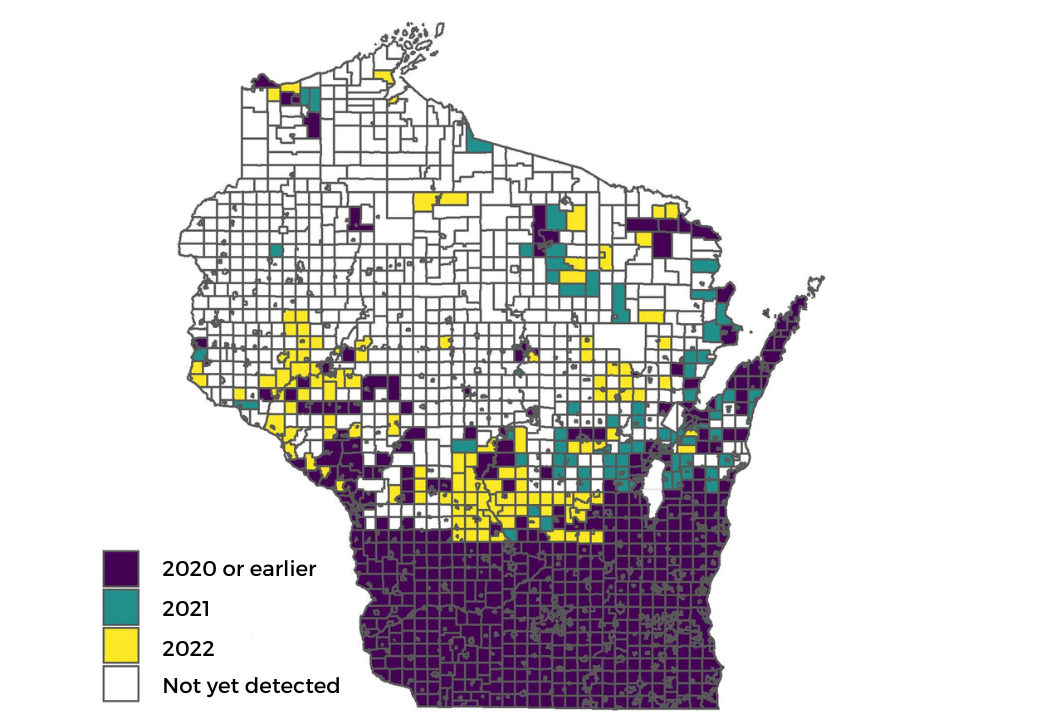|
|
Across the state, last week’s heat was replaced by more seasonable temperatures. Afternoon highs were comfortable and remained in the 70s and 80s, while overnight lows ranged from the lower 50s in the north to mid-60s in the south. Early-week storms July 11-12 generated light rain across northern and central Wisconsin that caused brief delays in alfalfa harvesting and spongy moth aerial spraying, but conditions were mostly dry and suitable for fieldwork. Surveys this week documented the arrival of migratory corn earworm moths from the southern US and an increase in emergence of western bean cutworm moths, which are now appearing in pheromone traps. In addition, Japanese beetles have become noticeably abundant in field crops, orchards, and residential areas.
__________________________________
  Western bean cutworm trap | DATCP
 
|
|
|
Emergence of western bean cutworm moths accelerated this week. DATCP’s network of pheromone traps registered a total of 168 moths for the period ending July 14, compared to 16 moths the previous week. The current state cumulative count is 184 moths in 36 traps. Based on the UNL-UMN flight model for this insect, 25% emergence of the adult population should occur in the next two weeks (July 17-31) across southern and central Wisconsin. Scouting pre-tassel corn to estimate egg density is recommended. In fields where egg masses and small larvae are found on 5% or more of the corn plants, a treatment applied at 90-95% tassel emergence will be most effective. The eggs are laid on the upper surface of the top 3-4 leaves, often on the flag leaf, and the larvae can be found in developing tassels.
Japanese beetles have also become common at low levels in corn, soybeans, and fruit crops, and perimeter damage can be expected this month. For corn, the primary concern is to protect the silks from clipping since heavy beetle feeding on corn silks can impair pollination. Treatment may be justified for fields with three or more beetles per ear and silks that have been clipped to ½ inch when pollination is occurring (less than 50% complete). Japanese beetles aggregate on plants in the edge rows, emphasizing the importance of obtaining a representative sample from several areas throughout the field before making control decisions. Border row spot treatments are sufficient if the beetles and damage are confined to the field edges.
   
|
|
 __________________________________
|
|
|
EAB infested tree | John Ehlke West Bend News
 
|
|
|
DATCP continues to receive and validate public and state agency reports of ash trees infested with emerald ash borer (EAB). This year, new detections have been recorded in Ashland, Bayfield, Forest, and Lincoln counties. Last year, reports resulted in three new county detections (Barron, Iron, and Langlade) and 235 new city, town, or village detections within previously confirmed counties. Municipal EAB detections now total 1,078 and encompass 47% of the state’s total acreage. There are no regulatory changes as a result of the recent detections.
Emerald ash borer was deregulated in 2021. It has been 20 years since the first confirmed U.S. detection of EAB in Detroit, Michigan and 14 years since its discovery in southeastern Wisconsin. Emerald ash borer has been confirmed in 66 of Wisconsin’s 72 counties since 2008. It is not necessary to report emerald ash borer in municipalities where it has already been detected, including much of the southern one-third of the state. However, DATCP is asking residents and landowners in central and northern Wisconsin counties or municipalities where it has not yet been detected to continue to report finds. To check the detection status of EAB in a county or to report an observation, visit DATCP’s interactive EAB detections map. Signs of infestation include thinning of the ash tree canopy, D-shaped exit holes, woodpeckers removing bark to feed on larvae, and new branches sprouting low on the trunk.
   
|
|
 __________________________________
|
|
|
|